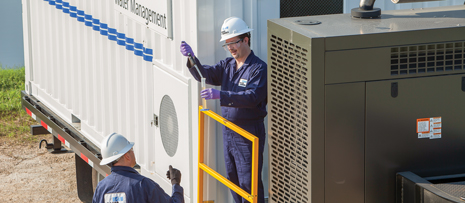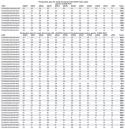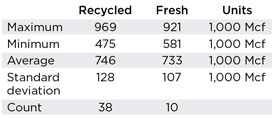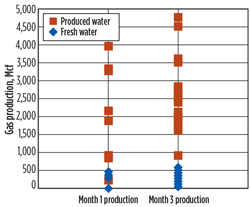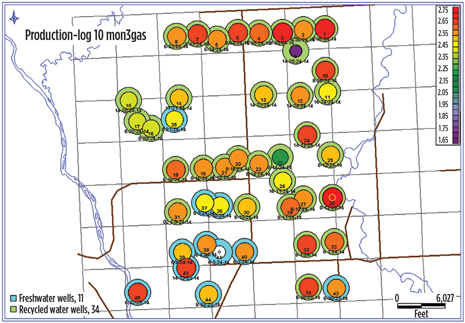Production gains through the reuse of produced water in fracturing
A 10-year production analysis suggests that the reuse of produced water in hydraulic fracturing results in better initial production, as well as longer-term equivalent output.
The rapid expansion in the use of hydraulic fracturing to unlock unconventional hydrocarbons over the last five years has created significant challenges in water management. The U.S. Environmental Protection Agency (EPA) estimates that 3.3 Bbbl of water were used in 2010 for fracturing in North America. Costs associated with the management of water, from sourcing through disposal, have been estimated to comprise as much as 15% of the overall cost of a well.1 Reuse of produced and flowback water to reduce costs has been an area of focus within the industry, but the practice has yet to become standard. While cost-effective technical solutions exist to treat these waters for reuse as an alternative to fresh water, a more fundamental question remains: What is the long-term impact, on production, of switching from the accepted practice of fresh water use to the use of produced water for hydraulic fracturing? This article details a 10-year production analysis, from a 48-well project completed in 2001.2 Comparing results using fresh water against those using flowback water for hydraulic fracturing suggests that reuse results in better initial production (IP), as well as equivalent production over 10 years. FRACTURING IN CANADAHydraulic fracturing is a hot button issue with polarizing effects. Publicity from groups opposed to the practice has raised public awareness; however, the presented information often lacks perspective and truth about how long the oil industry has been using the technique, the focus on safety in hydraulic fracturing, and the value that fracturing brings. Hydraulic fracturing was introduced in Canada in the early 1960s, as a method of extracting gas from low-permeability reservoirs, such as the Spirit River sandstone reservoirs in Alberta.3,4 Today, the vast majority of wells in the Horn River, Montney, Muskwa, Duvernay, and other shale plays, which extend from lower Manitoba, across Saskatchewan, Alberta, and upper British Columbia, are only possible through the application of hydraulic fracturing technology. In 2012, roughly 5,700 active wells in these shale plays, alone, produced 6.4 MMboed, annually.5 BENEFITS OF RECYCLINGThe availability of fresh water in Canada has not been as critical as in areas with limited sources of water, whether the restrictions are a result of drought, regulations or geology. However, regulations in Canada do seek to limit the amount of fresh water used for hydrocarbon recovery, resulting in about 90% of produced water in Canada being reinjected. In 2012, Canadian operators spent an estimated $3 billion treating and disposing of 2.9 MMcmd of produced water, which is approximately $2.90/m3. What if the cost of handling a waste product could be used, not to eliminate the waste, but to create a beneficial product to replace fresh water? Operators would save the expense of freshwater acquisition and logistics, as well as in other tangible ways. Some of the advantages include less chemicals, little or no clay swelling, lower scaling tendencies and reduced risk of formation damage. Some operators have expressed concern that produced water can cause formation damage. However, as early as 1989, there has been recognition that the use of fresh water, itself, could damage the formation.6 Another author said, “…just because we may be able to remove damage later is no license for needlessly incurring the damage in the first place.”7 A common practice of loading fresh water with chemicals, to simulate produced waters and avoid damage, is counterproductive to using water that is already ionically balanced with the formation water. Another concern is that produced water containing high levels of total suspended solids (TSS) will introduce fines that can plug the formation and reduce permeability. However, experience demonstrates that proper treatment easily mitigates this risk. Using produced water is better for the formation and, as presented in the case history, improves well productivity. METHODOLOGYFrac fluid system. Surfactant gelled fluids have been used for shallow gas applications of more than 3,000 treatments in 75 producing formations in the Western Canadian Sedimentary basin since 1998.2 The use of nitrogen, or carbon dioxide (CO2), to foam the base surfactant gel system, improves viscosity and leakoff control. Unfortunately, drought conditions resulted in delays or a lack of fresh water for the operator’s completions. Coupled with increased disposal costs, the lack of fresh water led to the development of a flowback reuse program. It was determined that the program reduced project costs 12%. Match waters to reuse technology and the frac system. Careful evaluation and characterization of each formation to be fractured is necessary for designing a successful treatment system. When a system is defined for stimulation, water requirements must be met to ensure success, both in the formulation of a fluid system and to meet production goals. Without such evaluation, problems like extended hydration times and elevated surface treating pressures can occur. Formation damage can also occur from suspended solids introduced during treatment, incompatible waters leading to scale deposition, microbial proliferation and corrosion. To minimize formation damage in this particular reuse application, flowback waters from previous surfactant gelled treatments were chosen. The premise for not using flowback waters from conventional completions was to avoid unknown contaminants in the water selected for reuse. One advantage of flowback reuse from surfactant-based gels is lower chemical demand. The anionic component of the gel system often remains in the flowback water, reducing chemical requirements by as much as 40%.2 The flowback waters selected exhibited minimal scaling potential. A critical concern, though, was the impact of suspended solids on the formation. Analysis led to a simple, yet effective, treatment method involving a 24-hr settling period, enabling the separation of solids and hydrocarbons, which greatly reduced costs typically associated with media filtration. The cleaned water is extracted and transferred to tanks, where it is combined with 48% fresh water.2 Fracturing locations. In the study, data were assessed from 48 wells that were hydraulically fractured; 38 used produced water and 10 used fresh water. The wells were completed in September 2001, in the Milk River formation of Alberta. The study wells exhibited similar characteristics. All wells were cased with a 114-mm ID and encompassed perforations averaging between 438.26 m, top, and 445.2 m, bottom, depth for an average 6.94-m interval. The completed wells used an average water volume of 34.78 m3 per job. Wells with reused flowback employed a ratio of 48% fresh water and 52% flowback water. STATISTICAL EXPERIMENTAL SETUPPopulation testing to distinguish samples. Critical to evaluating the difference in production, between wells using fresh water and produced water, is an analysis of the data. To determine the statistical significance of the data sets, an analysis of variance, or ANOVA, was utilized to identify differences between the two group averages. This method was selected to address any potential random sampling error between the two populations, and confirm any existing differences in average production of the two populations. RESULTS AND DISCUSSIONUsing the procedure described above, production data were collected for 10 wells fractured with fresh water and 38 wells fractured with recycled water from 2000 to 2011, Table 1. Production data for the study were provided by IHS Canada, a global information company. Well production was compared, based on gas production per hr. To determine the effect of recycled water on a well’s production, the cumulative output of each well set was compared. The comparison reveals that wells fractured with produced water have a slightly higher cumulative gas production than wells fractured with fresh water. The mean gas production from a well fractured with recycled water was 13,000 Mcf higher during the 11 years, with a 20% higher standard deviation, Table 2. When the cumulative gas production over all 11 years is compared, the results are nearly even.
To test if the variances in Table 2 were statistically different, an ANOVA test was performed, Table 3. Because the p-value in the ANOVA test was outside the 95% confidence interval, the two samples are assumed to be indicative of the same population. After reviewing more than 11 years of production data, wells fractured with recycled water are found to be statistically identical to wells fractured with fresh water.
However, this is not the whole story. Barring formation damage, the effect of frac water on a well’s production is expected to diminish naturally over time. When a hydraulic fracture is completed, the well is shut-in for a period of time until it is brought online for production. In the first few weeks of production, less than half of the water used for fracturing returns to the surface as flowback water.8 After the first few weeks, the well returns a blend of the original frac water and formation water. To determine the true effect of recycled water on production, the first few months of production must be examined more closely. Figure 1 shows a vertical scatter plot of the first and third month’s gas production, for wells fractured with fresh and recycled water. Table 4 shows production statistics for the same time period. The figure and table show that wells fractured with recycled water produce, on average, 25% more gas in the first month and 5% more gas in their third month than wells fractured with fresh water. As expected, the difference between the two well sets was highest in the first month and lower in the third month of production. It is important to test the result for statistical significance. Again, an ANOVA test was used to investigate whether the first- and third-month production of wells fractured with recycled water was greater than those wells fractured with fresh water. The p-value was inside the 95% confidence interval; therefore, production from wells fractured with recycled water is assumed to be statistically higher than wells fractured with fresh water.
To rule out the well location as the cause of this result, the first and third months of well production were plotted against the well’s latitude and longitude. Figure 2 shows that wells fractured with both recycled and fresh water occur in roughly the same area, although most of the wells fractured with recycled water were drilled in the northern part of the field. The blue outer circles represent wells fractured with fresh water; the green outer circles represent wells fractured with recycled water. The inner circle sizes and colors present average production.
The authors speculate that the slight, early production gain observed from the use of recycled water is from the inhibition of clay swelling. Clay swelling occurs when water devoid of dissolved mineral content (fresh water) comes into contact with reactive clay, such as Illite or Montmorillonite. The resulting swelling can block pore throats and decrease production until the offending water is exhausted.6 In the experiment mentioned in this article, inhibition of clay swelling could explain the first month’s production gain associated with produced water, as well as the associated reduction in the third-month results. CONCLUSIONSMore than a decade ago, in the shallow gas fields of western Canada, a group of fracture engineers set out to prove that recycled water could be gelled successfully with a novel surfactant frac system. The engineers wanted to distinguish if the recycled water was compatible with the fracturing fluid, and if it could be pumped downhole successfully. Recently, the authors were searching for a case history to demonstrate that the use of recycled flowback and/or produced water did not impact reservoir performance. Although this study was not optimized to test this theory, there is strong evidence that properly treated produced and flowback water does not negatively impact reservoir production and, in certain situations, this treated water can improve well performance during the first few months of output. The mechanism for improving productivity was speculated to be controlled by swollen reactive clays in the presence of fresh water with low mineral content. The phenomenon is well-understood and corresponds with the immediate flow increases observed during the first few months of production. This study is the first to demonstrate the performance of wells completed using recycled water over such a long period of time; it is a first step toward building operators’ confidence that water recycling can be a catalyst for production enhancement, cost reduction and increased environmental stewardship. Water requirements for fracturing most modern multi-stage horizontal wells are much higher than the subject wells; therefore, the authors expect production gains in modern wells to be higher than those observed in the aforementioned data. REFERENCES
|
|||||||||||||||||||||||||||||||||||||||||||||||||||||||||||||||||
- Shale technology: Bayesian variable pressure decline-curve analysis for shale gas wells (March 2024)
- What's new in production (February 2024)
- Prices and governmental policies combine to stymie Canadian upstream growth (February 2024)
- U.S. operators reduce activity as crude prices plunge (February 2024)
- U.S. producing gas wells increase despite low prices (February 2024)
- U.S. drilling: More of the same expected (February 2024)

